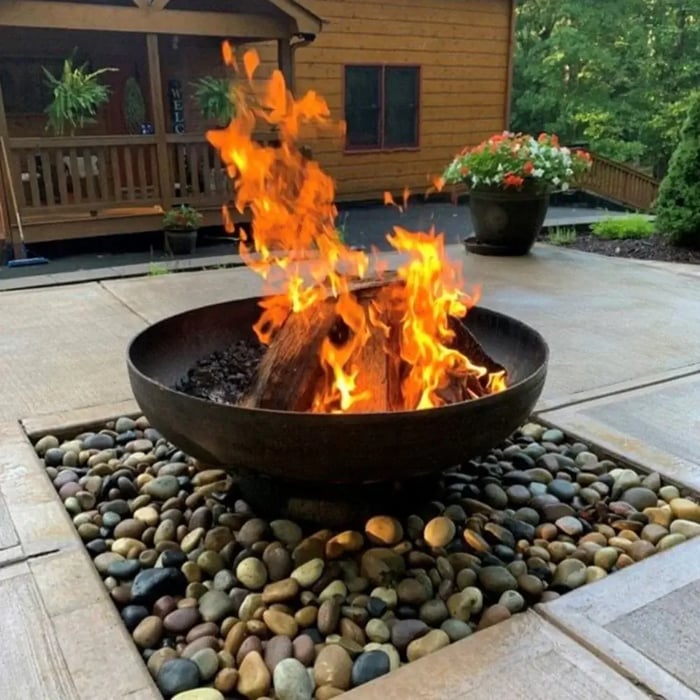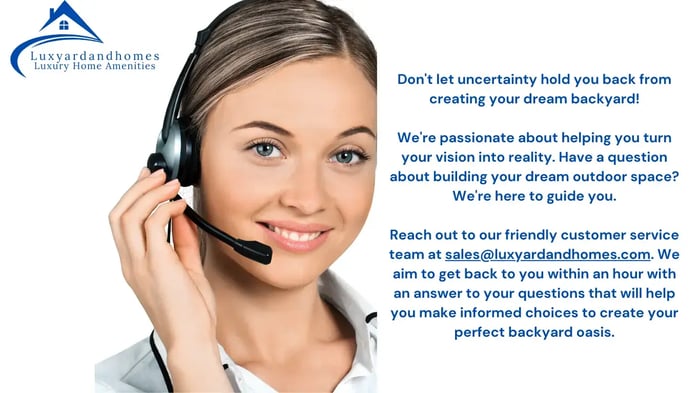Table of Contents
When it comes to creating a cozy and inviting outdoor space, a fire pit table is a must-have feature. However, deciding between a concrete or metal fire pit can be challenging. According to the Masonry Magazine, both materials offer unique advantages and disadvantages. Let's explore the key differences to help you make an informed decision.
This guide will delve into the key differences between a concrete fire pit table and a steel fire pit table. It will help you make an informed decision on which one is best for your outdoor living space. We'll cover their durability, maintenance requirements, costs, and aesthetic appeal of each type of fire pit.
Is Concrete a Good Material for a Fire Pit?
Yes, concrete is an excellent material for a fire pit. Its durability, aesthetic appeal, and low maintenance requirements make it a popular choice among homeowners. Concrete is known for its strength and can withstand harsh weather conditions. Its natural look complements various outdoor styles, and it requires minimal upkeep compared to other materials.
Key Features of a Concrete Fire Pit Table
Durability
Concrete is known for its strength and longevity, making it a great choice for outdoor features. It can withstand harsh weather conditions and high temperatures.
Aesthetics
Concrete offers a rustic, natural look that blends well with various outdoor styles.
Maintenance
Concrete fire pits require minimal maintenance, such as occasional cleaning.
Cost:
Concrete fire pits are generally more affordable than steel fire tables.
How Long Will a Concrete Fire Pit Table Last?
A well-constructed and maintained concrete fire pit can last for many years, often decades. Concrete is a durable material that can withstand harsh weather conditions, including extreme heat, cold, and moisture. This durability makes concrete fire pits a long-term investment for your outdoor space.
Factors that influence the lifespan of a concrete fire pit table
There a several factors that influence the lifespan of a concrete fire pit such as the following:
Quality of the concrete mix
A high-quality concrete mix with proper proportions of cement, sand, and aggregate will be more durable and resistant to cracking.
Installation:
Proper installation is crucial for the longevity of a concrete fire pit. Ensuring a level base and following installation guidelines can help prevent structural issues.
Local climate:
Harsh climates with frequent temperature fluctuations or freeze-thaw cycles can accelerate the deterioration of concrete.
Usage and maintenance:
Regular cleaning and maintenance can help extend the lifespan of a concrete fire pit. Avoid excessive heat or sudden temperature changes, as these can contribute to cracking.
Will a Concrete Fire Pit Crack?
Concrete fire pits, while durable, can develop hairline cracks over time. These cracks are often caused by factors such as:
- Harsh weather conditions: Extreme temperature fluctuations, freeze-thaw cycles, and heavy rainfall can contribute to cracking.
- Improper installation: A weak or uneven base can lead to stress on the concrete, causing it to crack.
- Excessive heat: Prolonged exposure to intense heat, especially from direct flames, can weaken the concrete and cause it to crack.
While hairline cracks are common in concrete structures, they typically do not significantly impact the performance of a fire pit. The primary concern is the potential for the cracks to widen over time, which could compromise the structural integrity of the fire pit.
To minimize the risk of cracking and ensure the longevity of your concrete fire pit, it's important to:
- Choose a high-quality concrete mix: A well-mixed concrete with proper proportions of cement, sand, and aggregate will be more resistant to cracking.
- Ensure proper installation: Hire a professional to install your fire pit on a level, stable base.
- Avoid extreme temperature fluctuations: Protect your fire pit from sudden temperature changes, especially during harsh weather conditions.
- Regularly inspect for cracks: Inspect your fire pit periodically for any signs of damage and address issues promptly.
By taking these precautions, you can help prevent hairline cracks and ensure that your concrete fire pit remains functional and enjoyable for many years to come.
Can You Burn Wood in a Concrete Fire Pit?
- Wood burning: While concrete fire pits are primarily designed for gas or propane, some can accommodate wood burning. However, wood burning can cause more wear and tear on the concrete.
- Safety considerations: Always follow local regulations and safety guidelines when burning wood in a concrete fire pit.
What Do You Put Under a Concrete Fire Pit?
- Protection: Place a heat-resistant pad or mat under your fire pit to protect the concrete surface from heat damage and staining.
Metal Fire Pits: A Durable and Versatile Option
 Traditional Steel Fire Pit
Traditional Steel Fire PitSteel fire pits offer a durable and versatile alternative to concrete fire pits. While both materials provide a sturdy foundation, steel fire pits are generally lighter, more modern in appearance, and often come in modular designs for added flexibility. However, they may require more maintenance to prevent rust and corrosion.
Concrete fire pits, on the other hand, are known for their durability, rustic aesthetic, and low maintenance requirements. They are typically heavier and less portable than steel fire pits, but they offer a more traditional look and can be a cost-effective option.
Ultimately, the best choice between a steel or concrete fire pit depends on your personal preferences, outdoor space, and budget. Consider your desired aesthetic, maintenance requirements, and budget to make an informed decision.
How Long Will a Steel Fire Pit Last?
A well-maintained steel fire pit can last for many years, often over a decade. The durability of a steel fire pit depends on several factors, including:
- Type of steel: Stainless steel and powder-coated steel are generally more resistant to rust and corrosion than other types of steel.
- Construction quality: A fire pit made from thick, high-quality steel will be more durable than one made from thinner or lower-quality materials.
- Maintenance: Regular cleaning, protection from rust and corrosion, and proper storage can significantly extend the lifespan of a steel fire pit.
- Exposure to the elements: Prolonged exposure to harsh weather conditions, such as rain, snow, and extreme temperatures, can accelerate the deterioration of steel.
By choosing a high-quality steel fire pit, providing proper maintenance, and protecting it from the elements, you can ensure that your fire pit will provide you with many years of enjoyment.
Types of Steel Fire Pits
Stainless steel
Offers excellent resistance to rust and corrosion.
Powder-coated steel
Provides a protective coating that enhances durability and aesthetics.
Wrought iron
Known for its intricate designs and durability.
Advantages of Steel Fire Pits
Portability
Steel fire pits are generally lighter and easier to move than concrete ones.
Versatility
Many steel fire pits come in modular designs, allowing for customization and flexibility.
Modern aesthetics
Steel fire pits often have a sleek and contemporary look.
Disadvantages of Steel Fire Pits
Higher cost
Steel fire pits can be comparable in price to concrete fire pits, but they may be more expensive in certain cases. For example, high-end steel fire pits with premium materials, intricate designs, or additional features like built-in seating or lighting can drive up the cost. Additionally, some brands or retailers may charge a premium for their steel fire pit products.
Maintenance
Steel fire pits require regular maintenance to prevent rust, corrosion, and premature wear. This includes:
- Remove ash and debris: After each use, clean out any remaining ash, embers, and debris from the fire pit. This helps prevent rust and corrosion and ensures a clean and safe environment for your next use.
- Scrub the surface: Use a stiff brush or scraper to remove any stubborn residue or stains from the steel surface. Avoid harsh chemicals that can damage the finish.
Protection from Rust and Corrosion:
- Protective coatings: Apply a protective coating or sealant to the steel surface to help prevent rust and corrosion. These coatings can be purchased at hardware stores and can be applied with a brush or spray.
- Cover when not in use: Cover your steel fire pit with a waterproof cover when it's not in use to protect it from rain, snow, and other elements that can accelerate rust.
- Store indoors: If possible, store your fire pit indoors during the off-season to provide additional protection from the elements.
The choice between a concrete or steel fire pit table depends on your personal preferences, outdoor space, and budget. Concrete fire pits offer durability and a rustic aesthetic, while steel fire pits provide portability and versatility. By carefully considering these factors, you can select the perfect fire pit to enhance your outdoor living area.
 Email us at sales@luxyardandhomes.com
Email us at sales@luxyardandhomes.com








